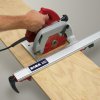For 95% of my cuts that are under 3' long or so I'll just use the factory edge on a piece of sheet goods 3/4" thick. Melamine, plywood, whatever. For 95% of my longer cuts I have a piece of plywood with a piece of aluminum angle rabbited into the edge of the plywood. The plywood is about 12" wide. Ripping full sheets of sheet goods I typically use the factory edge of another sheet or even a 'straight' piece of 1x lumber. I'll even use those factory straightedge clamps we are discussing but use a couple of C clamps to clamp them to make sure they don't move.
99.9% of the time it doesn't make a difference, for me, if the cut varies by 1/16" in 8'. Only time it's critical is if I'm going to edge join long cut edges.
Over the years I have come to accept that plumb, square, and parallel, straight are nice goals but not something to agonize over. Plus or minus a 1/32" is what I strive for. If it comes out plus/minus 1/16th" it's still good to go 95% of the time and move on. Obviously the smaller something is the less room for error. On typical projects I use my trusty framing square to check for squareness or if needed measure diagonals with my tape measure.
One last pointer, I don't agonize over cut lists. I mainly use them to try and get efficient use out of the lumber I have or try to decide how much to buy. When I start cutting, I do the major pieces first. Lets say sides, top and bottom of a medicine cabinet. Then I do the rabbits for the shelves and the inlaid back. Temporarily clamp it together and measure how big the inlaid back piece needs to be. Measure how long the rabbited shelves need to be. Now cut the back and intermediate shelves to those dimensions. That way if your rabbits were each off by 1/16" in depth you really don't/didn't care because you measured 'reality' and cut to that measurement.
Glue those pieces up. Now move on to the trim. Forget your cut list. Measure what reality is in your glued up box. Rough cut your trim so you don't have to man handle 8' to 12' pieces of trim. Until you gain some experience, cut your 1st pieces long by at least 1/8". Dry fit the cut pieces and then 'sneak up' on those final cuts and cut them.
Just don't get discouraged. I've been in this hobby for 50 years and still consider myself a average woodworker. Making furniture is typically beyond me but making something like kitchen cabinets I can hold my own. I'm getting into metal working/machining. Now there is a hobby than can absolutely drive you crazy and put you in the poor house real quick.
P.S. I've owned a jointer, I don't own one now and I don't miss it. With a good straightedge and a square based router I can do nice straight edges ready to glue.








